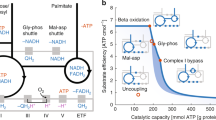Abstract
Endurance power of muscles is determined largely by the capacities to oxidize substrates in mitochondria in the process of making ATP by oxidative phosphorylation. This review explores physiological and morphological factors that may cause limitation of carbohydrate and fat utilization by muscle cells. The pathways for oxygen and substrates converge in muscle mitochondria. In mammals, a structural limitation of carbohydrate and lipid transfer from the microvascular system to muscle cells is reached at a moderate work intensity (that is, at 40–50% of V˙O2max). At higher work rates intracellular substrate stores must be used for oxidation. Because of the importance of these intracellular stores for aerobic work we find larger intramyocellular substrate stores in endurance trained athletes. The transfer limitations for carbohydrates and lipids on the level of the sarcolemma implies that the design of the respiratory cascade from lungs to muscle mitochondria reflects primarily oxygen demand.
This is a preview of subscription content, access via your institution
Access options
Subscribe to this journal
Receive 12 print issues and online access
$259.00 per year
only $21.58 per issue
Buy this article
- Purchase on Springer Link
- Instant access to full article PDF
Prices may be subject to local taxes which are calculated during checkout
Similar content being viewed by others
Author information
Authors and Affiliations
Rights and permissions
About this article
Cite this article
Hoppeler, H. Skeletal muscle substrate metabolism. Int J Obes 23 (Suppl 3), S7–S10 (1999). https://doi.org/10.1038/sj.ijo.0800878
Published:
Issue Date:
DOI: https://doi.org/10.1038/sj.ijo.0800878
Keywords
This article is cited by
-
Comparison of maximal lactate steady state with anaerobic threshold determined by various methods based on graded exercise test with 3-minute stages in elite cyclists
BMC Sports Science, Medicine and Rehabilitation (2020)
-
In focus in HCB
Histochemistry and Cell Biology (2020)
-
Divergence exists in the subcellular distribution of intramuscular triglyceride in human skeletal muscle dependent on the choice of lipid dye
Histochemistry and Cell Biology (2020)
-
Comparative histology of muscle in free ranging cetaceans: shallow versus deep diving species
Scientific Reports (2015)
-
The lipid droplet coat protein perilipin 5 also localizes to muscle mitochondria
Histochemistry and Cell Biology (2012)



